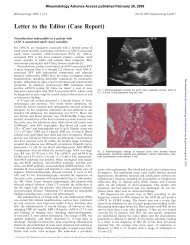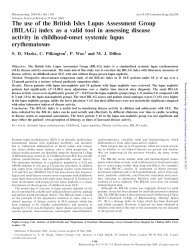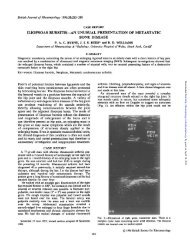WHIPLASH INJURIES - Rheumatology
WHIPLASH INJURIES - Rheumatology
WHIPLASH INJURIES - Rheumatology
You also want an ePaper? Increase the reach of your titles
YUMPU automatically turns print PDFs into web optimized ePapers that Google loves.
in chronic rheumatoid synovitis? Arthritis Rheum<br />
1990;33:768-73.<br />
20. Gay S. Gay RE. Cellular basis and oncogene<br />
expression of rheumatoid joint destruction. Rheumatol<br />
Int 1989;9:IO5-13.<br />
21.Mourad W, Mehindate, Schall TJ, McColl SR.<br />
Engagement of major histocompatibility complex<br />
class II molecules by superantigen induces inflammatory<br />
cytokine gene expression in human rheumatoid<br />
fibroblast-like synoviocytes. J Exp Med<br />
1992;175:613-6.<br />
22. Elias D, Reshef T, Birk OS, Zee R, van der, Walker<br />
MD, Cohen IR. Vaccination against autoimmune<br />
mouse diabetes with a T-cell epotope of the human<br />
65-kDa heat shock protein. Proc Natl AcadSci USA<br />
1991;88:3088-91.<br />
23. Lam KS, Salmon SE, Hersh EM, Hruby VJ, Kazmierski<br />
WM, Knapp RJ. A new type of synthetic<br />
peptide library for identifying ligandbinding activity.<br />
Nature 1991;354:82-4.<br />
24. Houghton RA, Pinilla C, Blondelle SE, Appel JR,<br />
Dooley CT, Cuervo JH. Generation and use of synthetic<br />
peptide recombinatorial libraries for basic<br />
research and drug discovery. Nature 1991;354:84-6.<br />
THE term whiplash describes the mechanism of acute<br />
flexion/hyperextension of the neck, a frequent feature<br />
of motor accidents. There is a spectrum of injury, ranging<br />
from minor tearing of muscle fibres to (rarely) vertebral<br />
fracture and spinal cord compression. Amongst<br />
the public whiplash injury has long been associated<br />
with chronic symptoms and financial compensation.<br />
The problem for a variety of clinicians, including rheumatologists,<br />
lies in identifying, the influence on the<br />
clinical picture of three important factors—genuine<br />
injury, psychological factors and compensation 'neurosis'.<br />
Success to date in this regard has been hampered<br />
largely by inadequate trial data and a modern medicolegal<br />
epidemic continues unchecked.<br />
Between 18 and 60 per cent of motor accidents<br />
(including front, side and rear impacts) give rise to<br />
whiplash injury [1,2]. Common symptoms are neck<br />
pain, headache and upper limb paraesthesiae while<br />
dysphagia and visual or auditory symptoms occur infrequently.<br />
A number of noteworthy features in the<br />
history suggest more severe injury including high speed<br />
of impact, major damage to the vehicle, head injury<br />
and immediate onset [3] or intense initial neck pain [4].<br />
Increasing age and radiographic evidence of cervical<br />
spondylosis are associated with the persistence of<br />
symptoms [4, 5] and along with the features of more<br />
severe injury may be useful in determining prognosis.<br />
Diffuse muscle tenderness and limitation of movement<br />
are the commonest clinical signs; neurological signs are<br />
rare, with root signs more frequent in those with cervical<br />
spondylosis. A review of cervical spine radiology in<br />
whiplash injury demonstrated prevertebral soft tissue<br />
swelling or angular deformity between vertebral<br />
bodies in 42 of 73 patients [5]. This high incidence of<br />
acute X-ray abnormalities has not been confirmed by<br />
others [6] while neither abnormality, surprisingly, was<br />
EDITORIALS 579<br />
<strong>WHIPLASH</strong> <strong>INJURIES</strong><br />
25. Hiraiwa A, Yamanaka K, Kwok WW, etal. Structural<br />
requirements for recognition of the HLA-Dwl4<br />
class II epitope: A key HLA determinant associated<br />
with rheumatoid arthritis. Proc Natl Acad Sci<br />
(USA) 1990;87:8051-5.<br />
26. Baccala R, Smith LR, Vestberg M, Peterson PA, Cole<br />
BC, Theofilopoulos AN. Mycoplasma arthritidis<br />
mitogen. Vbeta engaged in mice, rats, and humans,<br />
and requirement of HLA-DRalpha for presentation.<br />
Arthritis Rheum 1992;35:434-42.<br />
27. Denman AM, Pelton BK, Hylton W, Denman DJ.<br />
Clinical consequences of altering cytokine production<br />
in inflammatory connective tissue diseases. In:<br />
Baxter A, Ross R, eds. Cytokine interactions and<br />
their control. Chichester: John Wiley, 1991:155-75.<br />
28. Keffer J, ProbertL, CaziarisH, etal. Transgenic mice<br />
expressing human tumour necrosis factor: a predictive<br />
genetic model of arthritis. EMBO J<br />
1991;10:4025-31.<br />
29. Burch RM, Mahan LC. Oligonucleotides antisense to<br />
the interleukin 1 receptor mRNA block the effects<br />
of interleukin 1 in cultured murine and human fibroblasts<br />
and in mice. J Clin Invest 1992;88:1190-6.<br />
associated with the persistence of symptoms. The presence<br />
of neurological signs and cervical fracture or<br />
instability are indications for further investigation,<br />
particularly magnetic resonance imaging (MRI). This<br />
can demonstrate a range of injuries to bone, ligament<br />
or disc and indicate the degree, if any, of root or cord<br />
impingement [7].<br />
Management of simple whiplash injury consists of<br />
rest and analgesics for 1 to 2 weeks. A collar may usefully<br />
be worn during this period but should be gradually<br />
discontinued thereafter. Moulded collars holding the<br />
neck in slight flexion appear better than the standard<br />
soft collar [8]. A number of trials suggest that outpatient<br />
physiotherapy is no more effective in relieving<br />
pain and improving movement than merely advice on<br />
home mobilization by a physiotherapist [8, 9]. Proper<br />
communication between doctor and patient is important.<br />
A common mistake in primary care is to assure<br />
patients of healing within a couple of months as this<br />
only creates anxiety and loss of confidence when it does<br />
not occur. While mobilizing it should be stressed that<br />
neck discomfort related to reasonable activities is not<br />
retarding healing or creating a risk of permanent<br />
damage.<br />
Over 70% of patients settle in 2 to 3 months. Neurological<br />
symptoms and signs occasionally first develop<br />
some weeks after injury and are easily missed [3]. Judicious<br />
further physiotherapy may be useful for continuing<br />
symptoms, although clinical trials are lacking.<br />
The major problem in whiplash injury is the assessment<br />
and management of those patients who remain<br />
symptomatic more than 6 months after injury. This<br />
may be a significant percentage of the total (26% in one<br />
large retrospective series) [10] although others dispute<br />
such a high figure [11]. The term 'Late Whiplash Syndrome'<br />
(LWS) is useful to define this group who, in<br />
Downloaded from<br />
http://rheumatology.oxfordjournals.org/<br />
by guest on July 28, 2013
580 BRITISH JOURNAL OF RHEUMATOLOGY VOL. XXXI NO. 9<br />
addition to continuing symptoms of neck injury, frequently<br />
develop anxiety, insomnia and depressive<br />
symptoms. Many seem to cope poorly with what often<br />
appears to have been minor injury and are slow to<br />
regain their previous level of functioning, both socially<br />
and at work. Do some of these patients have injuries<br />
which are unrecognized and unresolved or are those<br />
with LWS either psychologically frail or conscious<br />
malingerers?<br />
The lack of adequate long term prospective studies,<br />
particularly of those not involved in litigation, makes it<br />
difficult to draw firm conclusions about LWS. There is<br />
no recognized symptom, clinical sign or radiographic<br />
feature which is characteristic of true unresolved<br />
injury. Attempts to identify pathological abnormalities<br />
using magnetic resonance imaging in LWS have yielded<br />
conflicting results [7, 12, 13]. Although the numbers in<br />
these studies are small one paper suggested avulsion of<br />
intervertebral disc from underlying end plate as a possible<br />
cause of LWS [7]. This finding was previously<br />
reported by MacNab [3] in seven patients whose persisting<br />
symptoms settled following surgical repair of<br />
the disc lesion.<br />
In the last 3 years studies of brain stem and spinal<br />
cord electrophysiology, two of which were controlled,<br />
have shown significant changes in oculomotor [14] and<br />
trigeminal sensory [15] nerve function and electronystagmographic<br />
abnormalities [16] in LWS. This may be<br />
due to the traction on spinal cord and associated neural<br />
structures which occurs as the trunk accelerates forwards<br />
at impact while the neck hyperextends. The<br />
importance of the changes is unclear but deserves<br />
further study.<br />
As already mentioned psychological symptoms are<br />
common in LWS. If these symptoms merely reflected a<br />
frail or susceptible personality type, it should be possible<br />
to predict the development of LWS from psychological<br />
profiles. However a well executed study [4]<br />
which performed such profiles in whiplash cases within<br />
1 week of injury found that the presence of neurotic or<br />
depressive traits at baseline was not predictive of outcome.<br />
Perhaps the psychological impact of the accident<br />
itself is a more important influence on the development<br />
of LWS. As suggested by Pearce [11], LWS shares<br />
many of the features of Post Traumatic Stress Disorder,<br />
a condition which can occur in any individual<br />
following a life-threatening event. Furthermore head<br />
injury, either from direct trauma or due to violent<br />
movement of the brain within the cranium at impact<br />
may also produce psychological disturbance. Natural<br />
frustration at the persistence of symptoms despite<br />
repeated assurances and numerous treatments may<br />
also play a role in illness behaviour in LWS.<br />
Those primarily seeking compensation present with<br />
unconvincing symptoms and inconsistent or inexplicable<br />
clinical signs. Where this is strongly suspected it is<br />
best to inform the patient that the complaints appear<br />
unrelated to the accident. Previously severe symptoms<br />
including muscle weakness, paraesthesiae and restricted<br />
neck movement often improve dramatically. True<br />
malingering is probably quite uncommon; this is sup-<br />
ported by indirect evidence such as the tendency for<br />
other injuries in whiplash cases to heal in the expected<br />
time [3], the similar numbers with LWS pursuing and<br />
not pursuing litigation [17,18] and the tendency for<br />
symptoms to persist for long periods following compensation<br />
[19].<br />
The management of LWS is largely empirical. Strong<br />
analgesics and hypnotics should be avoided and treatments<br />
minimally or temporarily effective are best discontinued.<br />
While maintaining a sympathetic approach<br />
patients should be encouraged to take responsibility<br />
for coping with their symptoms. Repeat cervical spine<br />
radiographs in flexion and extension occasionally<br />
reveals abnormal or restricted movement at one segment,<br />
which is easily missed at presentation when<br />
muscle spasm is often intense. This and the presence of<br />
unremitting paraesthesiae are possible indications for<br />
MRI.<br />
Long-term prospective trials of cases not involved in<br />
litigation are needed to answer some of the questions<br />
posed by whiplash injuries. Those factors suggesting<br />
more severe injury or persistence of symptoms should<br />
guide predictions of outcome and be used to promote<br />
early settlement of legal cases. The practice of awaiting<br />
the levelling off of symptoms before proceeding with<br />
the court case should be changed as this encourages<br />
malingering and can, in certain cases, prolong<br />
suffering.<br />
MAURICE BARRY<br />
<strong>Rheumatology</strong> Research Unit, Unit E6, Addenbrooke's<br />
Hospital, Hills Road, Cambridge CB2 2QQ<br />
REFERENCES<br />
1. Deans GT, Magalliard JN, Kerr M, Rutherford WH.<br />
Neck sprain—a major cause of disability following<br />
car accidents. Injury 1987;18:10-12.<br />
2. Larder DR, Twiss MK, MacKay GM. Neck injury to<br />
car occupants using seat belts. In: 29th Annual Proceedings<br />
of the American Association for Automobile<br />
Medicine. Des Plaines, III: American<br />
Association for Automobile Medicine 1985;153-65.<br />
3. MacNab I. Acceleration extension injuries of the cervical<br />
spine. In: Rothman R, Simeone F, eds. The<br />
spine, Vol. 2, 1975: Philadelphia: W. B. Saunders;<br />
515-28.<br />
4. Radanov BP, Di Stefano G, Schnidri A, Ballinari P.<br />
Role of psychosocial stress in recovery from common<br />
whiplash. Lancet 1991;338:712-15.<br />
5. Miles KA, Maimaris C, Finlay D, Barnes MR. The<br />
incidence and prognostic significance of radiological<br />
abnormalities in soft tissue injuries to the cervical<br />
spine. Skeletal Radiol 1988;17:493-6.<br />
6. PennieB, Agambar L. Patterns of injury and recovery<br />
in whiplash. Injury 1991 ;22:57-9.<br />
7. Davis SI, Teresi LM, Bradley WG, Ziemba MA,<br />
Bloze AE. Cervical spine hyperextension injuries:<br />
MR findings. Radiology 1991;180:245-51.<br />
8. Pennie B, Agambar LJ. Whiplash injuries. A trial<br />
of early management. J Bone Joint Surg [Br]<br />
1990;72:277-9.<br />
9. McKinney LA, Dornan JO, Ryan M. The role of<br />
physiotherapy in the management of acute neck<br />
sprains following road traffic accidents. Arch Emerg<br />
Med 1979;6:27-33.<br />
Downloaded from<br />
http://rheumatology.oxfordjournals.org/<br />
by guest on July 28, 2013
10. Balla JI. Report to the Motor Accidents Board of Victoria<br />
on whiplash injuries 1984. In: Hopkins A, ed.<br />
Headache problems in diagnosis and management.<br />
London: Saunders 1988:256-69.<br />
11. Pearce JMS. Whiplash injury: a reappraisal. J Neurol<br />
Neurosurg Psychiatry 1989;52:1329-31.<br />
12. Maimaris C. Neck sprains after car accidents. Br Med<br />
yi989;299:123.<br />
13. Rofo NMR. Tomography of the cervical spine.<br />
Fortschr Roentgenstr 1986;145:657-60.<br />
14. Hildingsson C, Wenngren BI, Bring G, Toolanen G.<br />
Oculomotor problems after cervical spine injury.<br />
Acta Orthop Scand 1989;60:573-6.<br />
15. Knibestol M, Hildingsson C, Toolanen G. Trigeminal<br />
1992<br />
October<br />
November<br />
November<br />
December<br />
1993<br />
February<br />
February<br />
March<br />
March<br />
May<br />
June<br />
September<br />
October<br />
October/<br />
November<br />
November<br />
9<br />
9-13<br />
13-14<br />
4<br />
11-12<br />
12-13<br />
24-26<br />
24<br />
13-14<br />
24-25<br />
23-24<br />
14-15<br />
31-5<br />
19-20<br />
EDITORIALS 581<br />
sensory impairment after soft-tissue injury of the<br />
cervical spine. Acta Neurol Scand 1990;82:271-6.<br />
16. Oosterveld WJ, Kortschot HW, Kingma GG, de Jong<br />
HAA, Saatcio MR. Electromyographic findings<br />
following cervical whiplash injuries. Acta Otolanyngol(Stockh)<br />
1991;lll:201-5.<br />
17. Gargan MF, Bannister GC. Long term prognosis of<br />
soft-tissue injuries of the neck. J Bone Joint Surg<br />
[Br] 1990;72:901-3.<br />
18. Hohl M. Soft tissue injuries of the neck in automobile<br />
accidents: factors influencing prognosis. J Bone<br />
Joint Surg [Am] 1974; 56:1675-82.<br />
19. Mendelson G. Not 'cured by a verdict'. Effect of legal<br />
settlement on compensation claimants. Med J Aust<br />
1982;2:132-4.<br />
ANNOUNCEMENTS AND CALENDAR FOR 1992-93<br />
Core Course in <strong>Rheumatology</strong>. LONDON (Dr D. Isenberg).<br />
Senior Registrar Travelling Fellowship. BIRMINGHAM (Prof. P. Bacon).<br />
Update Management of RA preceded by Midlands <strong>Rheumatology</strong> Society Meeting. COVENTRY<br />
(Dr J. Coppock).<br />
Closing dates for Abstracts for the BSR Xth AGM.<br />
Synovial Fluid. MANCHESTER (Dr A. Freemont).<br />
BSR Core Course on 'Examination and Radiology of Joints'. (Dr M. Doherty).<br />
BSR Xth AGM. HARROGATE.<br />
Update Vascular Endothelium. HARROGATE (Dr D. Haskard).<br />
Advanced Course in <strong>Rheumatology</strong>. GLASGOW (Prof. R. Sturrock).<br />
Rehabilitation Course. DERBY (Dr C. F. Murray-Leslie).<br />
Heberden Round. CAMBRIDGE (Dr B. Hazleman).<br />
Core Course. LIVERPOOL (Dr R. N. Thompson)<br />
SR Travelling Fellowship. LEEDS (Prof. V. Wright).<br />
BSR Paediatric <strong>Rheumatology</strong> Course. NEWCASTLE UPON TYNE (Dr I. D. Griffiths)<br />
CLOSING DATES FOR EDUCATION PRIZES FOR 1993<br />
Michael Mason Prize 1993 - 12 November 1992.<br />
BSR Non-Clinical Bursary 1993 - 16 September 1993.<br />
SR Travelling Fellowship 1993 - 31 May 1993.<br />
Further information about these events from Ms. H. Verraest, British Society for <strong>Rheumatology</strong>, 3 St Andrew's Place,<br />
Regent's Park, London NVV1 4LE.<br />
Downloaded from<br />
http://rheumatology.oxfordjournals.org/<br />
by guest on July 28, 2013















